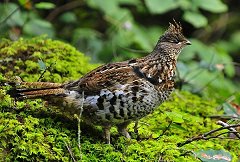
The East Sector Park is a new regional park, close to the Harrison Lagoon hotspot, and also appears to have tremendous potential to be a great birding site. Limited data to date has already tallied an impressive 83 species and, with the varied habitats that this site offers, a great many more are surely yet to be discovered.
The park has about 4km of trail to explore which winds through varied habitats. From the parking lot, the trail sysem begins with the Spirit Trail Loop which is prediminately mature ceders and some bigleaf maple and birch. From the midway part of the Spirit Trail Loop, access to the Bridle Trail is possible via a walkway. The habitat on the Bridle Trail is more varied with more open areas. The north and east parts of the trail seem the most birdy and also brings one through a small marsh, along the Miami Slough and the base of Bear Mountain. Decideous trees also dominate this section of the park.
Amenities at the park include a toilet, large kiosk sign, raised walkway and directional signs along the trails as well as some interpretive signs. Black bears appear fairly active at this site so do keep them in mind. Less frightening animal species seen at the site also include northern alligator lizard, rubber boa, coyote and black-tailed deer.
Birds
Spring gets off to a good start with several of the resident male Ruffed Grouse heard drumming daily throughout the park. They can also be counted on to give a visitor a heart attack when they fly up from the side of the trail as they walk by. Red-breasted Sapsuckers are also common. Black-throated Grey Warbler, when they arrive in May, are the most common warbler at the site and are found singing in all corners. Nashville Warbler are regular migrants and a few remain to breed. A walk along McPherson Road at the southern end of the park is a good place to find Lazuli Bunting as well as other species that like the farmland habitat at this part of the site including Eastern Kingbird and sparrow species. Other migrants include Pacific-slope Flycatcher, Western Tanager Black-headed Grosbeak, Swainson's Thrush and Willow Flycatcher and all will remain for the summer.
Many species breed here including at least the Warbling, Red-eyed and Hutton's Vireo and possibly Cassin's Vireo as well. Getting all four vireo species in one day is very possible. Black-throated Grey Warbler also obviously breeds at the site with many males still singing well into the summer to maintain their territories.
During the fall migration it is expected the site will receive a lot of bird activity if what is seen at the nearby Harrison Lagoon site is any indication. Virginia Rail have been heard at the site in the fall and well into the winter in the marshy area.
The winter months has the typical assortment of species such as finches, chickadees and Brown Creeper. Varied Thrush returns to the lowland area here from the hillsides from where they nested during the summer.

~By Jamie Gadsden - June 19, 2019 |